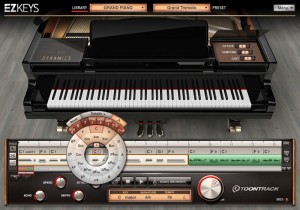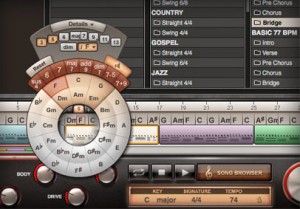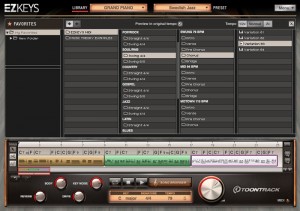Review: Toontrack EZ KEYS Grand Piano by Zach McNees
Most composers, engineers and producers will tell you that while you can get remarkably close with MIDI sounds and plug-in samplers, there are always a few instruments that seem too intricate and complex to be represented accurately in the box. At the top of the list would certainly be drums and piano.
Toontrack has gone above and beyond with their flagship Superior Drummer 2 engine and sample collections; their attention to detail and dynamics have helped create an incredibly natural sound that is – in my opinion – unparalleled in the drum sampling world.
Now, Toontrack has created a piano sampling plug-in – EZ KEYS Grand Piano – which addresses most all of the sonic and musical shortcomings associated with sample-based piano recording in the digital world. Let’s take a look and listen!
TECH SPECS: EZ KEYS Grand Piano is a Native-only plug-in for use on MAC and PC and retails for $179. Formats are RTAS, VST and AU at 32 and 64-bit where available and also as a standalone application. Product authorization for EZ KEYS and future Toontrack products has also been simplified as the plug-in itself can now access the user’s account and authorize automatically.
WHAT IT DOES: EZ KEYS is both a virtual instrument piano and independent MIDI sequencer plug-in all in one. A spectacular sounding Steinway Model D was sampled with incredible attention to detail. Features include drag and drop MIDI from available Toontrack custom piano libraries, smart transpose functions, and the ability to alter chords and full arrangements on the fly.
THE INTERFACE: On the surface, EZ KEYS lives up to its name with a very simple layout. A brilliant graphical depiction of a grand piano takes up the main space of the plug-in. The keys and pedals are all usable with the click of a mouse for quick sound checking.
Under the lid on each side of the piano are accessible controls for dynamics and tuning. At the bottom are controls that will look familiar to users of Toontrack’s “EZ” line of plug-ins. From left to right there are knobs for reverb, tone, detail, compression and a large main volume knob. The function of these knobs can change based on the settings of the preset selected. In the center is a display for the Key, Signature and Tempo of the song with the option to follow the host DAW. Otherwise, EZ keys works independently of your host.
Above the display are Stop, Play and Loop buttons and the song browser button. Selecting the song browser brings up the MIDI library where users can drag and drop MIDI which has been created exclusively for EZ KEYS. At the very top is a drop-down menu for various preferences, the “Library” where potential future EZ KEYS libraries might exist and finally a selection of preset sounds such as “Swedish Jazz” and “Old Time Boogie”. Finally, underneath the piano lies a timeline similar looking to GarageBand, where MIDI can be edited and pulled in for use.
IN USE: I had the chance to use EZ KEYS while working on some compositions of short music cues for television and also in a more traditional record environment demoing for an upcoming album by Toronto band Enter the Haggis.
The first thing that really struck me about EZ KEYS was the amazing sound of the instrument. The Steinway D sounds incredibly life-like and realistic with deep, rich low-end warmth and a crisp top end register. What’s most unique sonically about EZ KEYS is the wealth of dynamics and detail control available. Each key on the piano packs many separate dynamic points. Because of this, the actual sound of the piano will be drastically different depending on the style of music and velocity with which you play — just like a real piano. All three traditional piano pedals (soft pedal, sostenuto and sustain) are useful and help achieve an even more realistic and accurate sound.
One of the most notable sonic features of the piano is the detail knob, which you really have to hear to believe. The detail knob allows the user to control the subharmonic sounds (see: natural) created by the piano pedals being used and the hammers touching the strings. Separate knobs for Tone, Compression and Reverb are all available to help shape the sound. The Tone knob sounds best all the way at 100% where the true sound of the piano comes through. Adjusting down gives the piano an even warmer, more subtle tone.
The main reverb used is an excellent sounding hall with about 3.5 sec of decay. The reverb sound suits the piano perfectly due to the well-shaped top end, which has been rolled off substantially allowing the piano to really take shape within the reverb instead of it feeling like an unnaturally added effect.
Because EZ KEYS is such a remarkable sounding virtual instrument, I’ve included a few solo audio examples for you to check out here:
Bossa (dry with detail knob up)
[audio:https://www.sonicscoop.com/wp-content/uploads/2012/06/Bossa-dry-with-detail-knob-up.mp3|titles=Bossa (dry with detail knob up)]
Jazz
[audio:https://www.sonicscoop.com/wp-content/uploads/2012/06/Jazz.mp3|titles=Jazz]
One of the greats!
[audio:https://www.sonicscoop.com/wp-content/uploads/2012/06/One-of-the-greats.mp3|titles=One of the greats]
EZ KEYS obviously is packing a huge punch sonically just based on the sound of their piano. But, the heart of this plug-in lies in the MIDI world. Selecting the song browser brings up the EZ KEYS MIDI library where users can begin to build their song.
The MIDI libraries available within EZ KEYS were recorded exclusively for the plug-in by a professional session pianist in 8 bar sections. The available categories include: Basic Chords, Pop/Rock, Soul/RnB, Country, Gospel, Jazz, Latin, Blues, Boogie, Funk and various FX and endings. Within each category or genre are sub menus for Intro, Verse, Chorus etc. Breaking down even further, each song section is available in four different variations, each increasing in complexity. MIDI can be dragged directly onto the EZ KEYS sequencer where a wealth of additional controls and features are available.
Once you’ve brought some MIDI into the sequencer, EZ KEYS automatically analyzes the MIDI and gives you the basic chords and changes laid out for each bar. It’s worth noting that EZ KEYS can also import and analyze outside piano MIDI, making this plug-in even more powerful.
Selecting a chord brings up a circle of fifths wheel that will look familiar to anyone with musical training. The top section of the wheel are the chords that EZ KEYS has determined are the best fit for the song based on the key you’ve selected. Every chord played within EZ KEYS can be manipulated and changed within this wheel. For instance, you can select a basic C chord, and hear it with all the different variations and possibilities such as: Major, Minor, Maj 7, Dim 7, Add 9, Sus 4 etc.
An additional “Details” notch allows even further control over individual chords by removing or adding individual notes such as the 3, 5, 6, 9, 11 or 13 from the chord. The musical possibilities available here are deep, yet also very easy to experiment with and manipulate.
Once you’ve got your sequence put together, you can simply drag your MIDI out of EZ KEYS into your DAW. You are also free to keep the MIDI embedded within EZ keys and it will play when your host application is in playback.
The presets section of EZ KEYS features a variety of FX chains, which can further shape the sound of the piano. Some of the available presets are “Swedish Jazz”, “Old Time Boogie”, “Electric Dirt” and “Horror Score”. While some of the presets were interesting and fun to experiment with, I personally did find a use for them in my sessions. I was more than satisfied with the natural sound of the “Standard” preset.
There’s a great deal of power and possibilities under the hood of EZ KEYS. I highly recommend Toontrack’s website which showcases a number of different video tutorials that really dig in into the different sections of EZ KEYS.
TO BE CRITICAL: Again, the presets (while unique and interesting to listen to once or twice) don’t really bring anything exceptional to the table sonically that I would use on a regular basis. I suspect this won’t bother the vast majority of EZ Keys users though since they will be using the plug-in primarily because of its pristine sound and not because they want to alter it drastically or dramatically with lots of effects.
IN CONCLUSION: EZ KEYS is really a powerhouse plug-in! I’m impressed enough with the sound of the piano that I would be comfortable using EZ in conjunction with a nice weighted MIDI controller and pedal as an alternative to recording a real piano for a record. For me, that is truly the ultimate test of a MIDI instrument and EZ KEYS passes the test with flying colors.
While variations of many of the sonic features I’ve mentioned here, such as the detail control, are available in at least one other piano virtual instrument that I know of, EZ KEYS has more than double the dynamic levels available in any other plug-in I know of, and costs about half as much. $179 is an astounding price point for a plug-in that packs as much power, sound and flexibility as EZ KEYS. Absolutely thrilled to have this in my arsenal! Well done.
Click to demo or purchase EZ Keys Grand Piano via the Toontrack website. Also see demo videos of how to work with the included MIDI Library and features like “Smart Transpose“.
Zach McNees is a Brooklyn-based producer/engineer/mixer and live recordist who’s worked with Björk, Rob Thomas, Julia Nunes, The Gregory Brothers, Pixies, Liars and Alice Cooper. Get in touch with Zach via http://www.zachmcnees.com.










Jeremiah Bjorgaarad
July 19, 2012 at 3:26 pm (12 years ago)We love Toontrack EZ Keys! We just completed the first ez keys add-on a couple months ago and are giving it away as part of our Free Piano Loops drawing at http://freecountryloops.com/free-loops-drawing/
Craig Berry
March 29, 2013 at 5:50 pm (12 years ago)Yeah, it’s a pretty sweet plugin. You’re right about the expressiveness of these samples. Amazing.